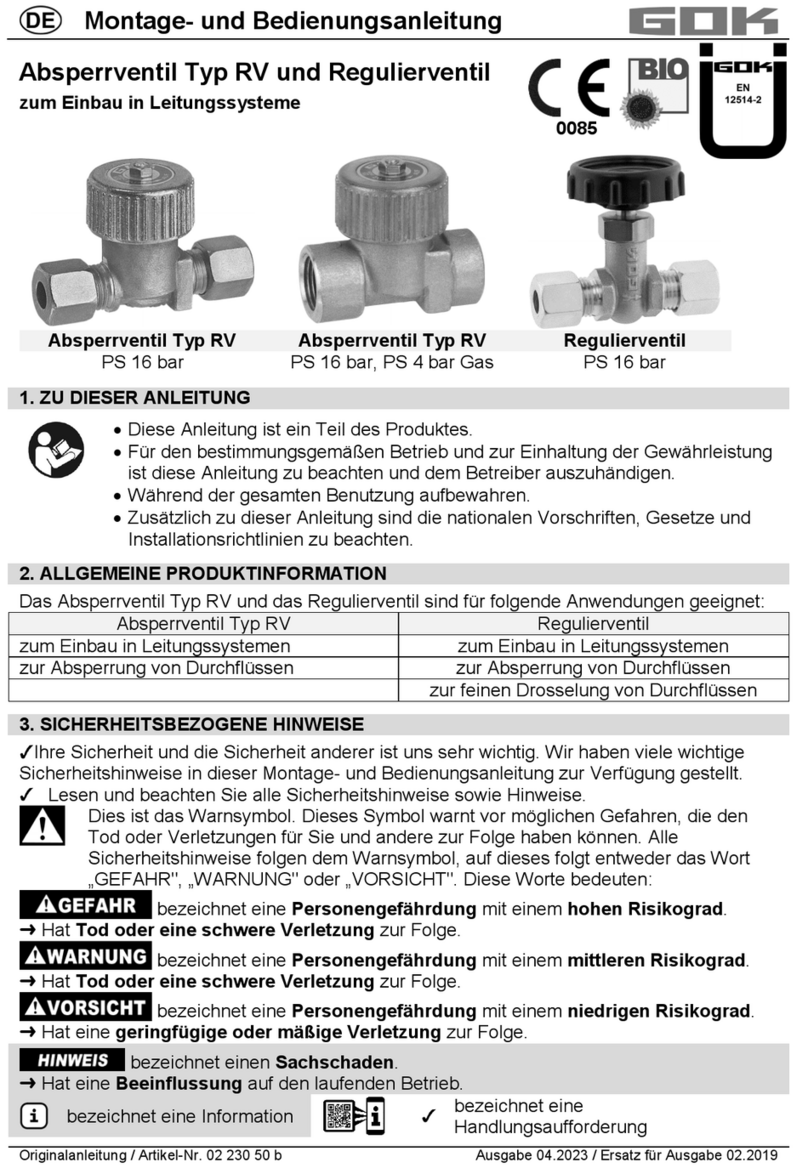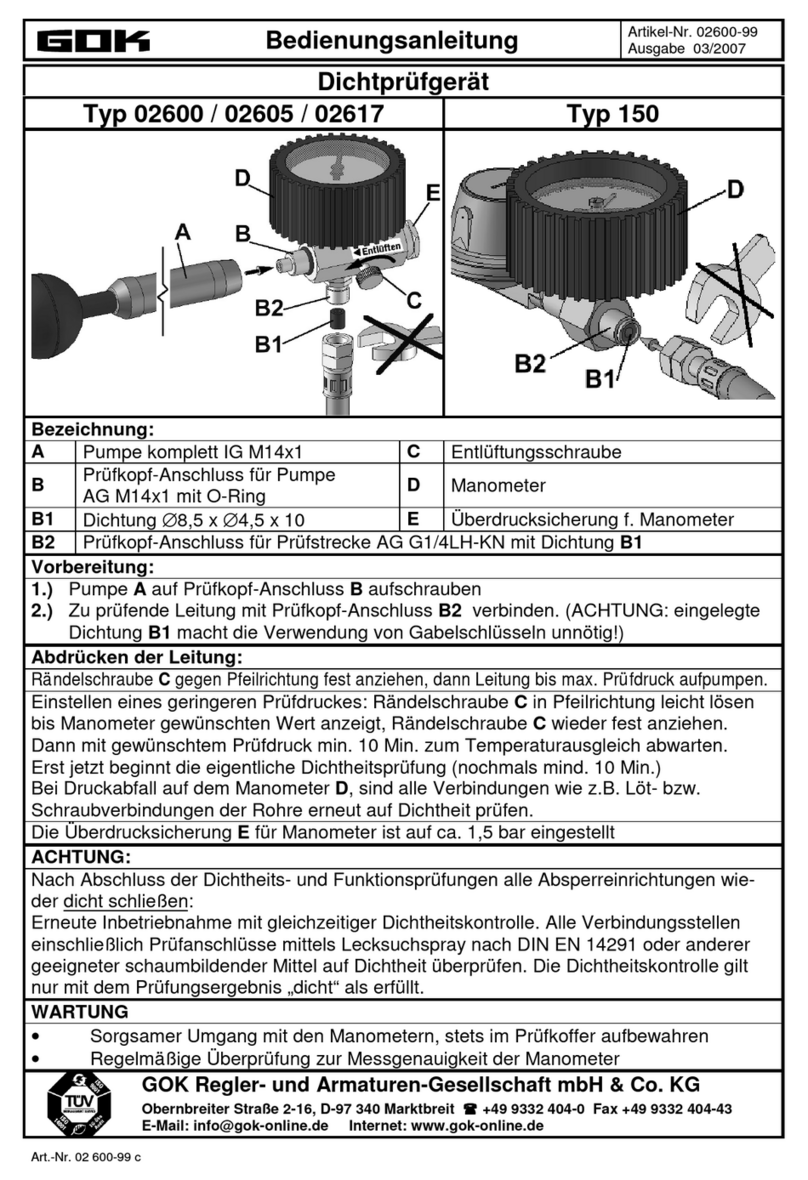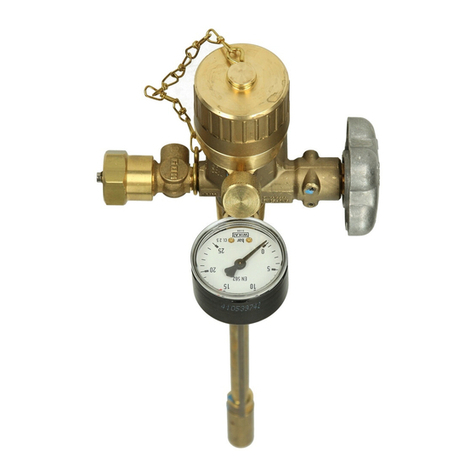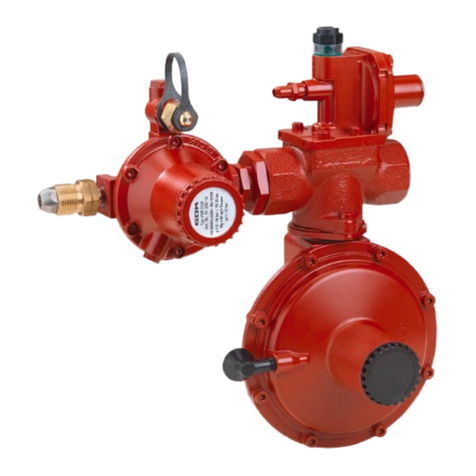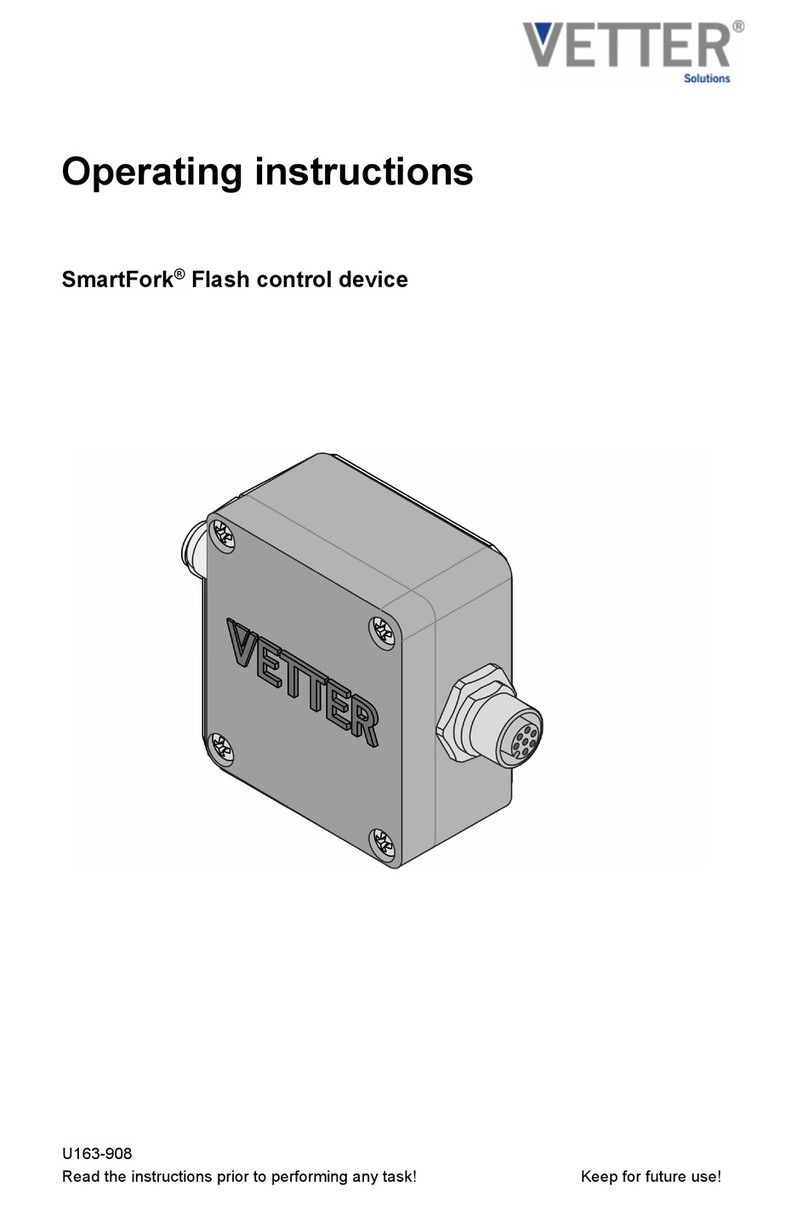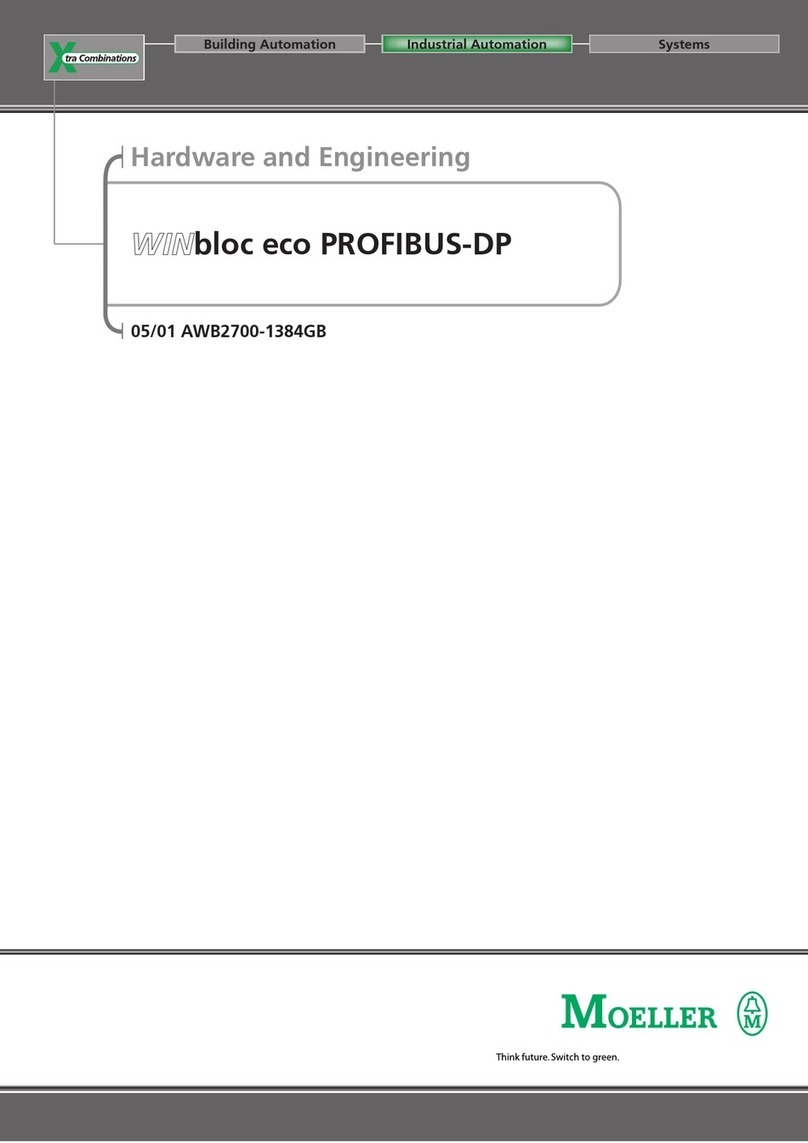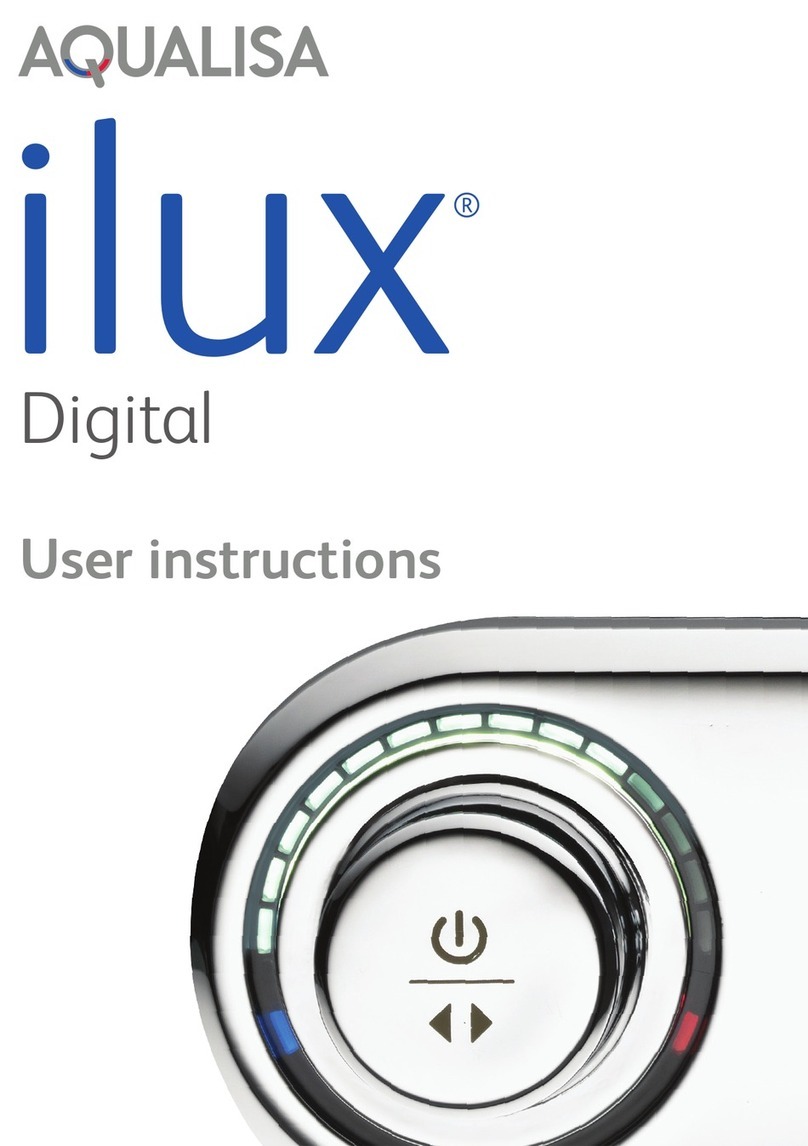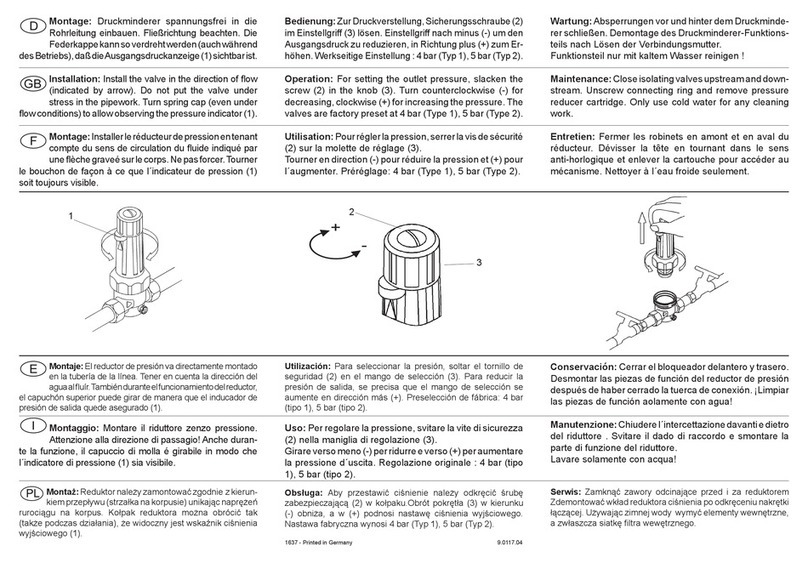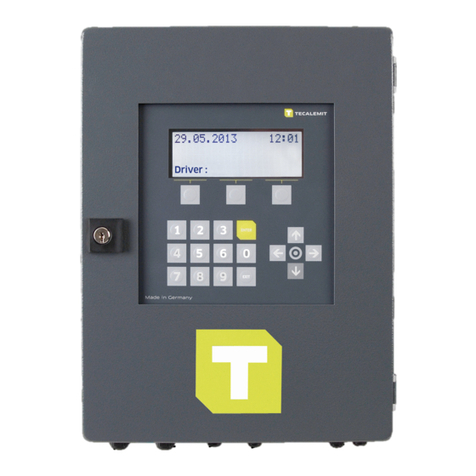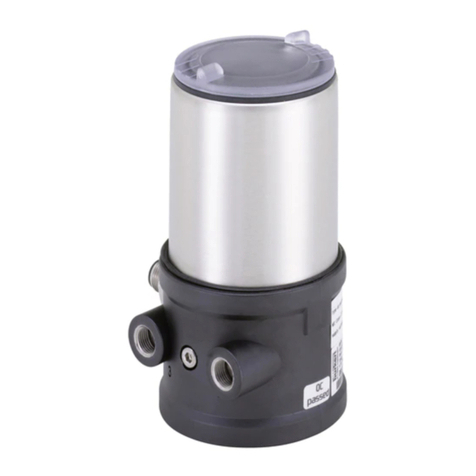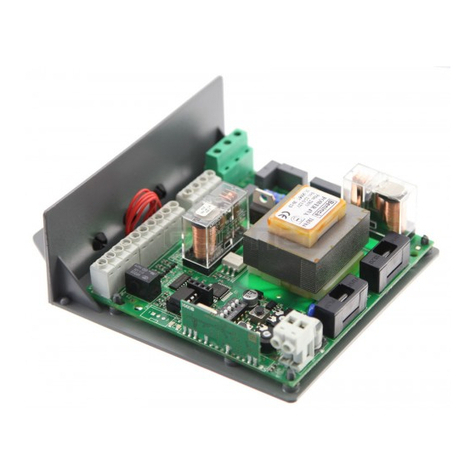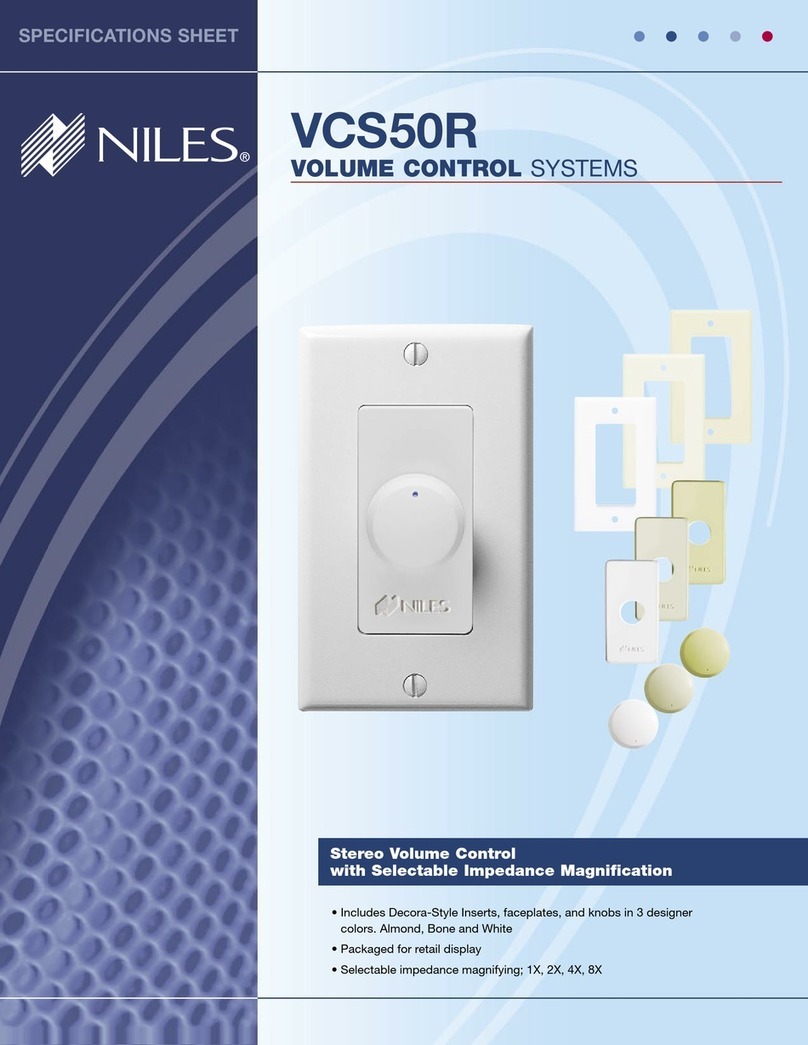GOK SBS User instructions

Originalanleitung / Artikel-Nr. 02 850 50 f Ausgabe 07.2019 / Ersatz für Ausgabe 03.2016
Montage- und Bedienungsanleitung
Schlauchbruchsicherung SBS
NIEDERDRUCK
Typ SBS/MA - manuell Typ SBS/AU - automatisch
MITTELDRUCK
Typ SBS/ST - manuell Typ SBS/MA 15 - manuell Typ SBS/MA - manuell
HOCHDRUCK
Typ SBS/ST - manuell Typ SBS/K - manuell
1. SICHERHEITSBEZOGENE HINWEISE
Ihre Sicherheit und die Sicherheit anderer ist uns sehr wichtig. Wir haben viele wichtige
Sicherheitshinweise in dieser Montage- und Bedienungsanleitung zur Verfügung gestellt.
Lesen und beachten Sie alle Sicherheitshinweise sowie Hinweise.
Dies ist das Warnsymbol. Dieses Symbol warnt vor möglichen Gefahren, die den
Tod oder Verletzungen für Sie und andere zur Folge haben können. Alle
Sicherheitshinweise folgen dem Warnsymbol, auf dieses folgt entweder das Wort
„GEFAHR", „WARNUNG" oder „VORSICHT". Diese Worte bedeuten:
bezeichnet eine Personengefährdung mit einem hohen Risikograd.
Hat Tod oder eine schwere Verletzung zur Folge.
bezeichnet eine Personengefährdung mit einem mittleren Risikograd.
Hat Tod oder eine schwere Verletzung zur Folge.
bezeichnet eine Personengefährdung mit einem niedrigen Risikograd.
Hat eine geringfügige oder mäßige Verletzung zur Folge.
bezeichnet einen Sachschaden.
Hat eine Beeinflussung auf den laufenden Betrieb.
bezeichnet eine Information bezeichnet eine Handlungsaufforderung

Artikel-Nr. 02 850 50 f
2. PRODUKTBEZOGENE SICHERHEITSHINWEISE
Ausströmendes Flüssiggas (Kategorie 1):
•ist extrem entzündbar
•kann zu Explosionen führen
•schwere Verbrennungen bei direktem Hautkontakt
Verbindungen regelmäßig auf Dichtheit prüfen!
Bei Gasgeruch und UndichtheitFlüssiggasanlage sofort außer Betrieb nehmen!
Zündquellen oder elektrische Geräte außer Reichweite halten!
Entsprechende Gesetze und Verordnungen beachten!
3. ZU DIESER ANLEITUNG
•Diese Anleitung ist ein Teil des Produktes.
•Für den bestimmungsgemäßen Betrieb und zur Einhaltung der Gewährleistung
ist diese Anleitung zu beachten und dem Betreiber auszuhändigen.
•Während der gesamten Benutzung aufbewahren.
•Zusätzlich zu dieser Anleitung sind die nationalen Vorschriften, Gesetze und
Installationsrichtlinien zu beachten.
4. VORTEILE UND AUSSTATTUNG
Die automatische Schlauchbruchsicherung SBS:
•öffnet selbsttätig
•schließt selbsttätig, dabei tritt eine geringe Überströmmenge aus
•öffnet bei langen Schlauchleitungen verzögert
Die manuelle Schlauchbruchsicherung SBS:
•muss manuell geöffnet werden (Bedienknopf)
•hat keine Verzögerung beim Öffnen
•schließt selbsttätig, dabei tritt keine Überströmmenge aus
5. BESTIMMUNGSGEMÄSSE VERWENDUNG
Betriebsmedien
•Flüssiggas (Gasphase)
Eine Liste der Betriebsmedien mit Angabe der Bezeichnung,
der Norm und des Verwendungslandes erhalten Sie im Internet unter
www.gok.de/liste-der-betriebsmedien.
Betreiberort
•Betrieb im Innen- und Außenbereich
Erstickungsgefahr durch ausströmendes Gas in geschlossenen Räumen!
Gas kann in höheren Konzentrationen zu Atemnot und Ohnmacht führen.
Bei Verwendung im Innenbereich für ausreichende Belüftung sorgen.

Artikel-Nr. 02 850 50 f
Einbauort Schlauchbruchsicherung SBS: Anwendungsbeispiele
Niederdruck
•zum Anschluss am
Ausgang des
Niederdruckreglers
•zur Absicherung von
Schlauchleitungen
Mitteldruck
•zum Anschluss am
Ausgang des
Mitteldruckreglers
•zur Absicherung von
Schlauchleitungen
Hochdruck
•zum direkten Anschluss
an Gasflaschen
•zur Absicherung von
Hochdruck-
Schlauchleitungen an
Flaschenbatterien
Zur Absicherung von Schlauchleitungen im Camping-Bereich müssen
Schlauchbruchsicherungen SBS ab einer Schlauchlänge größer 1500 mm eingesetzt
werden. Zur Absicherung von Schlauchleitungen bei gewerblichen Flüssiggasanlagen
müssen Schlauchbruchsicherungen SBS ab einer Schlauchlänge größer 400 mm
eingesetzt werden.
Zur Absicherung von Hochdruck-Schlauchleitungen bei „Betrieb während der Fahrt“
müssen Schlauchbruchsicherungen SBS eingesetzt werden.
6. NICHT BESTIMMUNGSGEMÄSSE VERWENDUNG
Jede Verwendung, die über die bestimmungsgemäße Verwendung hinausgeht:
• z. B. Betrieb mit anderen Betriebsmedien, Drücken
•Verwendung von Gasen in der Flüssigphase
•Einbau entgegen der Durchflussrichtung
•Betrieb mit nicht zulässigen Schlauchleitungen
•Änderungen am Produkt oder an einem Teil des Produktes
•Arbeiten unter Erdgleiche
•im durchgängigen und/oder unbeaufsichtigten Betrieb
Für Arbeiten unter Erdgleiche und im durchgängigen und/oder unbeaufsichtigten Betrieb
müssen Mitteldruckregler mit Leckgassicherung, z.B. Typ MD-LGS
Bestell-Nr. 02 880 01, eingesetzt werden.
Schlauchbruchsicherungen sind keine Druckregler.
Nach DGUV Vorschrift 79 § 11 Abs. 3 dürfen Verbrauchsanlagen nur mit einem gleich-
mäßigen, auf die Verbrauchseinrichtung abgestimmten Arbeitsdruck betrieben werden!

Artikel-Nr. 02 850 50 f
7. FUNKTIONSBESCHREIBUNG
Die Schlauchbruchsicherung SBS ist eine Sicherheitseinrichtung, welche bei Beschädigung
oder Lösen der Schlauchleitung den Gasaustritt verhindert.
Wird die Schlauchleitung beschädigt, und/oder der Nenndurchfluss wird um 10%
überschritten, entsteht ein plötzlicher Druckverlust und die Schlauchbruchsicherung SBS
schließt. Die Gaszufuhr zum angeschlossenen Verbraucher wird unterbrochen. Somit kann
kein Gas unkontrolliert ausströmen.
Ist die Ursache des Schließens der Schlauchbruchsicherung SBS behoben, kann die
Schlauchbruchsicherung SBS manuell wieder geöffnet werden.
Bei der automatischen Ausführung erfolgt die Inbetriebnahme der Schlauchbruchsicherung
über eine Impulsbohrung. Das Öffnen des Schließkegels erfolgt automatisch nach dem
Druckausgleich. Bedingt durch eine größere Länge der Schlauchleitung kann sich das Öffnen
verzögern.
8. AUFBAU
SBS manuell
SBS automatisch
Eingangsanschluss
Bedienknopf SBS manuell
Ausgangsanschluss
Pfeil der Durchflussrichtung
9. ANSCHLÜSSE
SBS Niederdruck Eingang x Ausgang Montagehinweis
IG 1/4 LH-ÜM x AG 1/4 LH-KN
Schlüsselweite SW 17
(Sechskant)
Anzugsdrehmoment 10 Nm
RST 8 x RST 8
Rohrstutzen RST x
Rohrstutzen RST
mit Überwurfmutter Typ M und
Schneidring Typ D
nach DIN EN ISO 8434-1
IG 1/4 LH-ÜM x
AG 1/4 LH-KN
Schlüsselweite SW 17
(Sechskant)
Anzugsdrehmoment 10 Nm
IG G 1/2 x IG G 1/2
Zur Aufnahme einer
Einschraubverschraubung
mit O-Ring,
IG-Innengewinde zylindrisch

Artikel-Nr. 02 850 50 f
SBS Mitteldruck
Eingang x Ausgang
Montagehinweis
IG 3/8LH-ÜM x AG 3/8LH-KN
Schlüsselweite SW 19 (Sechskant)
Anzugsdrehmoment 15 Nm
IG G3/8 x IG G3/8
oder
IG G G1/2 x IG G1/2
Zur Aufnahme einer
Einschraubverschraubung
mit O-Ring,
IG-Innengewinde zylindrisch
STN x RVS 8
Stecknippel STN x
Rohrverschraubung RVS zum
Anschluss an Steckkupplung SKU
RST 8 x RVS 8
Rohrstutzen RST x
Rohrverschraubung RVS nach
DIN EN ISO 8434-1
SBS Hochdruck
Eingang x Ausgang
Montagehinweis
Komb.A x AG 3/8 LH-KN
Kombinationsanschluss (Komb.A)
mit Polyamid Dichtung und
Überwurfmutter
W 21,8 x 1/14-LH ÜM
Benutzen Sie dieses
Produkt erst, nachdem
Sie die Montage- und
Bedienungsanleitung
aufmerksam gelesen haben.
AG 1/2 LH-KN
10. MONTAGE
Vor der Montage ist das Produkt auf Transportschäden und Vollständigkeit zu prüfen.
Alle nachfolgenden Hinweise dieser Montage- und Bedienungsanleitung müssen vom
Fachbetrieb, Betreiber und Bediener beachtet, eingehalten und verstanden werden.
Voraussetzung für ein einwandfreies Funktionieren der Anlage ist eine fachgerechte
Installation unter Beachtung der für Planung, Bau und Betrieb der Gesamtanlage gültigen
technischen Regeln.
Verletzungsgefahr durch herausgeblasene Metallspäne!
Metallspäne können Ihre Augen verletzen.
Schutzbrille tragen!
Funktionsstörungen durch Rückstände!
Die ordnungsgemäße Funktion ist nicht gewährleistet.
Sichtkontrolle auf eventuelle Metallspäne oder sonstige Rückstände in den Anschlüssen
vornehmen!
Metallspäne oder sonstige Rückstände durch vorsichtiges Ausblasen unbedingt entfernen!
wahlweise
Gasflaschenanschluss

Artikel-Nr. 02 850 50 f
Die Montage ist gegebenenfalls mit einem geeigneten Werkzeug vorzunehmen.
Bei Schraubverbindungen muss immer mit einem zweiten Schlüssel am Anschlussstutzen
gegengehalten werden.
Ungeeignete Werkzeuge, wie z. B. Zangen, dürfen nicht verwendet werden!
Beschädigung des Produktes durch falsche Einbaurichtung!
Die ordnungsgemäße Funktion ist nicht gewährleistet.
Einbaurichtung beachten (diese ist auf dem Produkt erkennbar mit einem Pfeil
gekennzeichnet)!
Anschluss und Verlegen von Schlauchleitungen
Schlauchleitungen so anschließen, dass mechanische, thermische und chemische
Belastungen vermieden werden:
mechanische Belastung: z. B. Schlauchleitung nicht über scharfe Kanten ziehen
thermische Einwirkung: z. B. offene Flammen, Strahlungswärme vermeiden
chemische Einwirkung: z. B. Fette, Öle, ätzende Stoffe vermeiden
Schlauchleitungen spannungsfrei montieren (keine Biege- und Zugspannung oder Torsion).
Schlauchleitungen so verlegen, dass sich ihre Verbindungen nicht unbeabsichtigt lösen
können.
Anschlüsse am Druckregler mit Abgang 90° vermeiden das Knicken der Schlauchleitung.
Die gültigen nationalen Installationsvorschriften für Flüssiggasanlagen beachten.
Schraubverbindungen
Explosions-, Brand- und Erstickungsgefahr durch Undichtheit der Anschlüsse!
Kann durch Verdrehen des Produktes zu Gasaustritt führen.
Produkt nach der Montage und beim Nachziehen der Anschlüsse nicht mehr verdrehen!
Nachziehen von Anschlüssen nur in vollständig drucklosem Zustand!
10.1. MONTAGEHINWEIS SBS HOCHDRUCK
Zum Anschluss an die Gasflaschen müssen geeignete Hochdruck-
Schlauchleitungen verwendet werden!
10.2. MONTAGEHINWEIS SBS MITTELDRUCK
Tabelle 1: Absicherbare Schlauchleitungslänge in Meter mit Nenn-Innendurchmesser
von 4,0 mm ± 0,4 mm (Toleranzbereich nach EN 16436-1)
Durchfluss
3,0 kg/h
4,0 kg/h
6,0 kg/h
10,0 kg/h
12,0 kg/h
15,0 kg/h
Nenn-
druck
1,5 bar
15
-
30
8
-
16
2
-
7
3,0 bar
45
-
> 50
30
-
45
12
-
22
1,2
-
4
4,0 bar
> 50
45
-
> 50
20
-
40
4
-
10
2
-
7
Tabelle 2: Absicherbare Schlauchleitungslänge in Meter mit Nenn-Innendurchmesser
von 6,3 mm ± 0,5 mm (Toleranzbereich nach EN 16436-1)
Durchfluss
3,0 kg/h
4,0 kg/h
6,0 kg/h
10,0 kg/h
12,0 kg/h
15,0 kg/h
Nenn-
druck
1,5 bar
> 50
40
-
> 50
20
-
40
5
-
15
3
-
10
1,5
-
4
3,0 bar
> 50
45
-
> 50
20
-
40
10
-
30
5
-
20
4,0 bar
> 50
35
-
> 50
25
-
45
13
-
30

Artikel-Nr. 02 850 50 f
Tabelle 3: Absicherbare Schlauchleitungslänge in Meter mit Nenn-Innendurchmesser
von 9,0 mm ± 0,5 mm (Toleranzbereich nach EN 16436-1)
Durchfluss
3,0 kg/h
4,0 kg/h
6,0 kg/h
10,0 kg/h
12,0 kg/h
15,0 kg/h
Nenn-
druck
1,5 bar
> 50 > 50 > 50 > 50
40
-
> 50
25
-
40
3,0 bar
> 50 > 50
4,0 bar
11. FUNKTIONSPRÜFUNG
Die Funktion der Schlauchbruchsicherung SBS ist wie folgt zu testen:
Verbrennungs- oder Brandgefahr!
Schwere Hautverbrennungen oder Sachschäden.
Keine offenen Flammen zur Prüfung verwenden!
1. Gasflaschenventil schließen.
2. Schlauchleitung vom Verbraucher trennen.
3. Mit dem Daumen die Öffnung der Schlauchleitung verschließen (nicht Hochdruck!).
4. Gasflaschenventil langsam öffnen.
5. Knopf der Schlauchbruchsicherung SBS für drei Sekunden gedrückt halten:
Schlauchbruchsicherung SBS ist aktiviert.
6. Daumen vom Ende der Schlauchleitung nehmen:
die Schlauchbruchsicherung SBS spricht an, ein „PLOP“ ist zu hören,
die Gaszufuhr ist unterbrochen, es kann nur eine geringe Restmenge
aus der Schlauchleitung ausströmen.
7. Schlauchleitung am Verbraucher anschließen.
8. Gasflaschenventil öffnen und DICHTHEITSKONTROLLE durchführen.
Für die automatische SBS entfällt Punkt 5, da diese nach einiger Zeit automatisch
öffnet.
12. DICHTHEITSKONTROLLE
Verbrennungs- oder Brandgefahr!
Schwere Hautverbrennungen oder Sachschäden.
Keine offenen Flammen zur Prüfung verwenden!
Dichtheitskontrolle vor Inbetriebnahme
Vor Inbetriebnahme sind die Anschlüsse des Produktes auf Dichtheit zu prüfen!
1. Alle Absperrarmaturen der angeschlossenen Verbraucher schließen.
2. Gasentnahmeventil oder Gasflaschenventil(e) langsam öffnen.
3. Ist eine Sicherheitseinrichtung (z.B. SBS, EFV) zu dem angeschlossenen Verbraucher
zwischengeschaltet, ist diese bei der Dichtheitsprüfung zu öffnen.
4. Alle Anschlüsse mit schaumbildenden Mitteln nach EN 14291
(z. B. Lecksuchspray, Bestell-Nr. 02 601 00) einsprühen.
5. Dichtheit prüfen, indem auf Blasenbildung im aufgesprühten schaumbildenden Mittel
geachtet wird.
Bilden sich weitere Blasen, müssen die Anschlüsse nachgezogen
werden (siehe MONTAGE). Falls sich die Undichtheiten nicht beseitigen lassen,
darf das Produkt nicht in Betrieb genommen werden.
Für Deutschland sind auch die Prüfvorgaben nach TRF 2012 (Kapitel 8.3) zu berücksichtigen.
Für die automatische SBS entfällt Punkt 3, da diese nach einiger Zeit automatisch
öffnet.

Artikel-Nr. 02 850 50 f
Ammoniak, das in einigen Seifen und Reinigungsmitteln
enthalten ist, greift Armaturen an.
Armaturen können nach Kontakt mit Ammoniak nach einigen Monaten Risse
bekommen und Leckagen auftreten.
Ammoniakhaltige Seifen und Reinigungsmittel nicht für dieses Produkt verwenden!
13. INBETRIEBNAHME
Das Produkt ist nach MONTAGE und erfolgreicher DICHTHEITSKONTROLLE betriebsbereit.
1. Alle Absperrarmaturen der angeschlossenen Verbraucher müssen geschlossen sein.
2. Gasentnahmeventil oder Gasflaschenventile langsam öffnen.
3. Bedienknopf der Schlauchbruchsicherung SBS für einige
Sekunden drücken. Die Schlauchleitung füllt sich mit Gas.
4. Angeschlossene Verbraucher sind betriebsbereit.
5. Bedienungsanleitung der angeschlossenen Verbraucher
beachten!
Für die automatische SBS entfällt Punkt 3, da diese nach einiger Zeit automatisch
öffnet.
14. BEDIENUNG
Im Falle des Auslösens der Schlauchbruchsicherung SBS muss das Ventil (in der
Versorgungsleitung, an der Gasflasche oder an dem Druckregler) geschlossen werden.
Das Ventil darf erst dann wieder geöffnet werden, wenn der Grund für das Auslösen der
Schlauchbruchsicherung SBS beseitigt wurde.
Das Ventil muss immer in der vollständig „Offen“-Stellung sein, wenn das Ventil
Einstellmöglichkeiten hat, die zwischen vollständig „Offen“ und vollständig „Geschlossen“
liegen.
Damit wird gewährleistet, dass die Schlauchbruchsicherung SBS ordnungsmäßig funktioniert.
15. FEHLERBEHEBUNG
Fehlerursache
Maßnahme
Gasgeruch
Ausströmendes Flüssiggas
ist extrem entzündbar!
Kann zu Explosionen führen.
Gaszufuhr schließen!
Keine elektrischen Schalter betätigen!
Nicht im Gebäude telefonieren!
Räume gut belüften!
Flüssiggasanlage außer Betrieb nehmen!
Fachbetrieb beauftragen!
Schlauchleitung ist beschädigt
Gasflaschenventil sofort schließen.
Schlauchleitung ersetzen.
Schlauchbruchsicherung SBS
Mitteldruck spricht nicht an
Länge und Nenn-Innendurchmesser der
Schlauchleitung laut Tabelle 1-3 kontrollieren.
Kein Gas am Verbraucher
Bedienknopf der Schlauchbruchsicherung SBS drücken
(siehe INBETRIEBNAHME).
Alle Anschlüsse der Versorgungsleitung nach der SBS
auf Dichtheit prüfen.
Füllstand der Gasflasche kontrollieren.
16. INSTANDSETZUNG
Führen die unter FEHLERBEHEBUNG genannten Maßnahmen nicht zur ordnungsgemäßen
Wiederinbetriebnahme und liegt kein Auslegungsfehler vor, muss das Produkt zur Prüfung an
den Hersteller gesandt werden. Bei unbefugten Eingriffen erlischt die Gewährleistung.

Artikel-Nr. 02 850 50 f
17. AUSTAUSCH
Bei Anzeichen jeglichen Verschleißes und jeglicher Zerstörung des Produktes oder eines
Teiles des Produktes muss dieses ausgetauscht werden.
Bei Austausch des Produktes Schritte MONTAGE, DICHTHEITSKONTROLLE und
INBETRIEBNAHME beachten!
Um unter normalen Betriebsbedingungen die einwandfreie Funktion der Installation zu
gewährleisten, wird empfohlen, die Einrichtung vor Ablauf von 10 Jahren nach dem
Herstellungsdatum auszutauschen.
18. WARTUNG
Das Produkt ist nach ordnungsgemäßer MONTAGE und BEDIENUNG wartungsfrei.
19. AUSSERBETRIEBNAHME
Gaszufuhr und dann Absperrarmaturen der angeschlossenen Verbraucher schließen.
Bei Nichtbenutzung der Flüssiggasanlage alle Ventile geschlossen halten.
Alle freien Anschlüsse in den Zuleitungen der Flüssiggasanlage sind mit einem
geeigneten Verschluss dicht zu verschließen, um ausströmendes Gas zu vermeiden!
20. ENTSORGEN
Um die Umwelt zu schützen, dürfen unsere Produkte nicht mit dem Hausmüll
entsorgt werden.
Das Produkt ist über örtliche Sammelstellen oder Wertstoffhöfe zu entsorgen.
21. TECHNISCHE DATEN
21.1. TECHNISCHE DATEN NIEDERDRUCK
Nenndruck
29; 50; 70 - 200 mbar
Nenndurchfluss Mg
maximal 12 kg/h
Maximal zulässiger Druck PS
16 bar
Umgebungstemperatur
-20 °C bis +50 °C
Gehäusewerkstoff
Messing CW617N
21.2. TECHNISCHE DATEN MITTELDRUCK SBS/ST
Nenndruck
0,3 bar bis 4,0 bar fest eingestellt
Nenndurchfluss Mg
maximal 30 kg/h
Maximal zulässiger Druck PS
16 bar
Umgebungstemperatur
-20 °C bis +50 °C
Gehäusewerkstoff
Messing CW617N oder Zinkdruckguss ZP0410
21.3. TECHNISCHE DATEN HOCHDRUCK
Typ ST - manuell
Typ K - manuell
Nenndruck fest eingestellt
6,0 bar bis 10,0 bar
0,3 bar bis 16 bar
Nenndurchfluss bei 0,3 bar
Mg max. 1,5 kg/h
Nenndurchfluss bei 6 bar
Mg 10 kg/h bis 12 kg/h
Nenndurchfluss bei 10 bar
Mg 12 kg/h
Maximal zulässiger Druck PS
16 bar
Umgebungstemperatur
-20 °C bis +50 °C
Gehäusewerkstoff
Messing CW617N
CW617N oder ZP0410
Weitere technische Daten oder Sondereinstellungen siehe Typschild des Produktes!

Artikel-Nr. 02 850 50 f
22. GEWÄHRLEISTUNG
Wir gewähren für das Produkt die ordnungsgemäße Funktion und Dichtheit
innerhalb des gesetzlich vorgeschriebenen Zeitraums. Der Umfang unserer
Gewährleistung richtet sich nach § 8 unserer Liefer- und Zahlungsbedingungen.
23. TECHNISCHE ÄNDERUNGEN
Alle Angaben in dieser Montage- und Bedienungsanleitung sind die Ergebnisse der
Produktprüfung und entsprechen dem derzeitigen Kenntnisstand sowie dem Stand der
Gesetzgebung und der einschlägigen Normen zum Ausgabedatum. Änderungen der
technischen Daten, Druckfehler und Irrtümer vorbehalten. Alle Abbildungen dienen
illustrativen Zwecken und können von der tatsächlichen Ausführung abweichen.
24. SERVICE
Unter der Adresse www.gok-blog.de finden Sie Antworten auf besonders häufig
gestellte Fragen aus den Themenbereichen Flüssiggasanlagen, Flüssiggas in der
Freizeit, Ölfeuerungsanlagen und Tankmanagement.
25. ZERTIFIKATE
Unser Managementsystem ist zertifiziert nach ISO 9001, ISO 14001 und
ISO 50001 siehe:
www.gok.de/qualitaets-umwelt-und-energiemanagementsystem.
Regler- und Armaturen-Gesellschaft mbH & Co. KG
Obernbreiter Straße 2-18 • 97340 Marktbreit / Germany
Tel.: +49 9332 404-0 • Fax: +49 9332 404-43
E-Mail: info@gok-online.de • www.gok.de • www.gok-blog.de

Translation of the original operating instructions / part no. 02 850 50 f Version 07.2019
Assembly and operating manual
Excess flow device SBS
LOW PRESSURE
Type SBS/MA - manual
Type SBS/AU - automatic
MEDIUM PRESSURE
Type SBS/ST manual Type SBS/MA 15 - manual Type SBS/MA - manual
HIGH PRESSURE
Type SBS/ST - manual Type SBS/K - manual
SAFETY ADVICE
Your safety and the safety of others are very important to us. We have provided many
important safety messages in this assembly and operating manual.
Always read and obey all safety messages.
This is the safety alert symbol.
This symbol alerts you to potential hazards that can kill or hurt you and others.
All safety messages will follow the safety alert symbol and either the word
“DANGER”, “WARNING”, or “CAUTION”. These words mean:
describes a personal hazard with a high degree of risk.
May result in death or serious injury.
describes a personal hazard with a medium degree of risk.
May result in death or serious injury.
describes a personal hazard with a low degree of risk.
May result in minor or moderate injury.
describes material damage.
Has an effect on ongoing operation.
describes a piece of information describes a call to action

Excess flow device SBS
2
PRODUCT-RELATED SAFETY ADVICE
Escaping liquid petroleum gas (category 1):
•is highly flammable
•may cause explosions
•severe burns in case of direct skin contact
Regularly check connections for leak-tightness.
If you smell gas or detect a leak, shut the system down immediately.
Keep ignition sources and electrical devices out of reach.
Observe applicable laws and regulations.
ADVANTAGES AND EQUIPMENT
The automatic excess flow device SBS:
•opens automatically
•closes automatically; in this, a low overflow volume escapes
•opens with a delay in the case of long hose assemblies
The manual excess flow device SBS:
•requires manual opening (control knob)
•no delay during opening
•closes automatically; in this, no overflow volume escapes
ABOUT THE MANUAL
•This manual is part of the product.
•This manual must be observed and handed over to the operator to ensure that
the component operates as intended and to comply with the warranty terms.
•Keep it in a safe place while you are using the product.
•In addition to this manual, please also observe national regulations, laws and
installation guidelines.
INTENDED USE
Operating media
•LPG (gas phase)
You will find a list of operating media with descriptions, the relevant
standards and the country in which they are used in the Internet at
www.gok.de/liste-der-betriebsmedien.
Place of operation
•operate indoors and outdoors
Risk of asphyxiation from gas leaks in enclosed spaces!
High concentrations of gas can cause difficulty in breathing and lead to unconsciousness.
Please provide for sufficient ventilation during indoor use.

Excess flow device SBS
3
Installation location excess flow device SBS: Application examples
Low pressure
•connection to the outlet
of the low pressure
regulator
•protection of hose
assemblies
Medium pressure
•connection to the outlet
of the medium pressure
regulator
•protection of hose
assemblies
High pressure
•direct connection to gas
cylinders
•protection of high-
pressure hose
assemblies in multiple
bottle arrays
To protect hose assemblies in camping applications, excess flow devices SBS with
hoses longer than 1500 mm must be used. To protect hose assemblies in commercial
LPG systems, excess flow devices SBS with hoses longer than 400 mm must be
used. To protect high-pressure hose assemblies during „operation while driving“
excess flow devices SBS must be used.
INAPPROPRIATE USE
All uses exceeding the concept of intended use:
• e.g. operation using different media, pressures
•use of gases in the liquid phase
•installation against the flow direction
•operation with inappropriate hose assemblies
•changes to the product or parts of the product
•underground work
•in continuous and/or non-supervised mode
For underground work and in continuous and/or non-supervised mode, medium
pressure regulators with leak gas protection, e.g. type MD-LGS
part no. 02 880 01, must be used.
Excess flow devices are no pressure regulators.

Excess flow device SBS
4
Pursuant to DGUV Directive 79 § 11 section 3, consumer units may only be operated
at a uniform operating pressure adjusted to the consumer line!
FUNCTION DESCRIPTION
The excess flow device SBS is a safety equipment preventing gas from escaping when the
hose assembly is damaged or has come loose.
If the hose assembly is damaged and/or if the nominal flow rate is exceeded by 10 %, a
sudden pressure loss occurs and the excess flow device SBS closes. The gas supply to the
connected consumer is interrupted. This way, gas is prevented from escaping in an
uncontrolled manner.
Once the reason causing the excess flow device SBS to be closed has been remedied, the
excess flow device SBS can be re-opened manually.
Regarding the automatic version, the excess flow device is started up via a pulse bore. The
closing taper opens automatically when the pressure has equalised. Due to a longer hose
assembly the opening process may be delayed.
DESIGN
SBS manual
SBS automatic
Inlet connection
Outlet connection
Control knob SBS manual
Arrow for flow direction
CONNECTIONS
SBS low pressure
Inlet x Outlet
Installation note
G 1/4 lh cap nut F x
G 1/4 lh insider taper M
Spanner size 17 (Hexagonal)
Tightening torque 10 Nm
RST 8 x RST 8
Pipe socket RST x pipe socket RST
with coupling nut type M
and olive type D
pursuant to DIN EN ISO 8434-1
G 1/4 lh nut F x G 1/4 lh M
Spanner size 17 (Hexagonal)
Tightening torque 10 Nm
G 1/2 F x G 1/2 F
For accepting a screw-in connector
with O-ring,
female thread, cylindrical

Excess flow device SBS
5
SBS medium
pressure
Inlet x Outlet
Installation note
G 3/8 lh nut F x G 3/8 lh M
Spanner size 19 (Hexagonal)
Tightening torque 15 Nm
G 3/8 F x G 3/8 F
or
G 1/2 F x G 1/2 F
For accepting a screw-in connector
with O-ring,
female thread, cylindrical
STN x RVS 8
Plug-in fitting STN x
pipe coupling RVS for connection to
quick coupler SKU
RST 8 x RVS 8
Pipe socket RST x
pipe coupling RVS
pursuant to
DIN EN ISO 8434-1
SBS high pressure
Inlet x Outlet
Installation note
Komb.A x G 3/8 lh M
Combined fitting (Komb.A) with
polyamide gasket and coupling nut W
21.8 x 1/14 lh nut
Use this product only
when you have
carefully read the
assembly and operating
manual.
G 1/2 lh M
ASSEMBLY
Before assembly, check that the product is complete and has not suffered any damage during
transport. The specialised company and the operator must observe, comply with and
understand all of the following instructions in this assembly and operating manual. For the
system to function as intended, it must be installed professionally in compliance with the
technical rules applicable to the planning, construction and operation of the entire system.
Risk of injuries due to blown-out metal chips!
Metal chips may cause eye injuries.
Wear safety goggles!
Malfunctions caused by residues! Proper functioning is not guaranteed.
Visually check that there are no metal chips or other residues in the connections!
It is important that metal chips or other residues are blown out!
optionally

Excess flow device SBS
6
Install with suitable tools, if required.
Regarding screw connections, use a second spanner to brace against the connection nozzle.
Do not use unsuitable tools, such as pliers.
Product damaged through incorrect installation direction
Proper functioning is not guaranteed.
Observe the installation direction (marked on the product with an arrow ).
Connecting and installing hoses assemblies
Connect hoses so that mechanical, thermal and chemical stresses are avoided:
mechanical stress: e.g. do not pull the hose assembly over sharp edges
thermal effect: e.g. avoid open flames, radiant heat
chemical effect: e.g. avoid grease, oil, caustic substances
Install hose assemblies so that they are not under tension (no bending and tensile strains or
torsion).
Install hose assemblies so that their connections cannot loosen unintentionally.
Connections to the pressure regulator with 90° outlet prevent the hose assembly from being
kinked.
Observe the applicable national installation regulations for LPG systems.
Screw connections
If connections leak, there is a danger of explosion, fire or suffocation!
Gas may escape if the product is turned.
Do not turn the product after it has been installed and the connections have been
tightened.
Tighten connections only when they are not pressurised.
INSTALLATION NOTE SBS HIGH PRESSURE
To connect to the gas cylinder, suitable high pressure hose assembly must be used!
INSTALLATION NOTE SBS MEDIUM PRESSURE
Table 1: Protection-compatible hose assembly length in metres with rated internal
diameter of 4.0 mm ± 0.4 mm (tolerance range pursuant to EN 16436-1)
Flow rate
3.0 kg/h
4.0 kg/h
6.0 kg/h
10.0 kg/h
12.0 kg/h
15.0 kg/h
Nominal
pressure
1.5 bar
15
-
30
8
-
16
2
-
7
3.0 bar
45
-
> 50
30
-
45
12
-
22
1.2
-
4
4.0 bar
> 50
45
-
> 50
40
4
-
10
2
-
7
Table 2: Protection-compatible hose assembly length in metres with rated internal
diameter of 6.3 mm ± 0.5 mm (tolerance range pursuant to EN 16436-1)
Flow rate
3.0 kg/h
4.0 kg/h
6.0 kg/h
10.0 kg/h
12.0 kg/h
15.0 kg/h
Nominal
pressure
1.5 bar
> 50
40
-
> 50
20
-
40
5
-
15
3
-
10
1.5
-
4
3.0 bar
> 50
45
-
> 50
20
-
40
30
5
-
20
4.0 bar
> 50
35
-
> 50
-
30

Excess flow device SBS
7
Table 3: Protection-compatible hose assembly length in metres with rated internal
diameter of 9.0 mm ± 0.5 mm (tolerance range pursuant to EN 16436-1)
Flow rate
3.0 kg/h
4.0 kg/h
6.0 kg/h
10.0 kg/h
12.0 kg/h
15.0 kg/h
Nominal
pressure
1.5 bar
> 50 > 50 > 50 > 50
40
-
> 50
25
-
40
3.0 bar
> 50 > 50
4.0 bar
FUNCTION CHECK
The excess flow device SBS must be tested for functionality as follows:
Risk of injuries or fire!
Serious burns to the skin or damage to property.
Do not use an open flame to check for leaks!
1. Close the gas cylinder valve.
2. Detach the hose assembly from the consumer.
3. Use your thumb to close the hose assembly opening (not high pressure)
4. Slowly open the gas cylinder valve.
5. Hold pressed the knob of the excess flow device SBS for three seconds:
excess flow device SBS is activated.
6. Remove your thumb from the end of the hose assembly:
the excess flow device SBS responds, a “PLOP” sound can be heard,
the gas supply is interrupted and only a small residual amount can escape from the
hose assembly.
7. Connect the hose assembly to the consumer.
8. Open the gas cylinder valve and perform LEAK TESTING.
Item 5 is not applicable to the automatic SBS, since it opens automatically after some
time.
LEAK CHECK
Risk of burning or fire
Serious burns to the skin or damage to property.
Do not use an open flame to check for leaks.
Leak check before start-up
Before start-up, check the product connections for leaks!
1. Close all shut-off fittings on the connected devices.
2. Slowly open the withdrawal valve or the gas cylinder valve(s).
3. If there is a safety device (e.g. EFV) between the tank and the connected device(s),
open this during the leak check.
4. Spray all connections with a foam producing substance according to EN 14291
(e.g. leak detector spray, Part no. 02 601 00).
5. Bubbles will form in the foam producing substance if there are any leaks.
If more bubbles form, re-tighten the connections (see ASSEMBLY). If
you cannot stop the leaks, you must not use the product.

Excess flow device SBS
8
Item 3 is not applicable to the automatic SBS, since it opens automatically after some
time.
Ammonia, contained in some soaps and cleaning agents, corrodes fittings.
After a couple of months, fittings that have made contact with ammonia may show
cracks or leakages.
Ammonia-containing soap and cleaning agents may not be used for this product!
START-UP
After the product has been ASSEMBLED and LEAK TESTING has been carried out
successfully, it is immediately ready for operation.
1. All shut-off fittings on the connected consumers must be closed.
2. Slowly open the gas withdrawal valve or the gas cylinder valves.
3. Hold pressed the control knob of the excess flow device
for a few seconds. The hose assembly is filled with gas.
4. Connected consumers are ready-to-operate.
5. Observe the assembly and operating manual of the
connected consumers!
Item 3 is not applicable to the automatic SBS, since it opens automatically after some
time.
OPERATION
If the excess flow device SBS has been triggered, the valve (in the supply line, on the gas
cylinder, or on the pressure regulator) must be closed.
The valve may only be re-opened once the reason for the excess flow device SBS being
triggered has been eliminated.
The valve must always be in the completely “open” position if the valve disposes of setting
options between completely “open” and completely “closed”.
This is to ensure that the excess flow device SBS works properly.
TROUBLESHOOTING
Fault cause
Action
Gas smell
Leaking LPG is extremely
flammable.
Can cause explosions.
Close the gas supply.
Do not use any electric switches.
Do not use a phone in the building.
Ventilate rooms well.
Shut down the LPG system.
Contact a specialised company.
Hose assembly is defective
Immediately close the gas cylinder valve.
Replace the hose assembly.
Excess flow device medium
pressure does not respond
Check length and nominal internal diameter of the hose
line pursuant to Tables 1-3.
No gas at the consumer
Press the control knob of the excess flow device SBS
(see STARTUP).
Check all connections of the supply line downstream of
the SBS for leak-tightness.
Check the level of the gas cylinder.

Excess flow device SBS
9
RESTORATION
If the actions described in TROUBLESHOOTING do not lead to a proper restart and if there is
no dimensioning problem, the product must be sent to the manufacturer to be checked. Our
warranty does not apply in cases of unauthorised interference.
REPLACEMENT
If there is any sign of wear or if the product or parts thereof are damaged, it must be replaced.
When the product has been replaced, observe the steps ASSEMBLY, LEAK TESTING and
START-UP.
MAINTENANCE
Upon proper ASSEMBLY and OPERATION, the product is maintenance-free.
SHUT-DOWN
Close the gas supply and then the shut-off fittings of the connected loads. When the LPG
system is not in use, all valves must remain closed.
Close all free connections in the feed lines of the LPG system tightly with a
suitable cap to prevent gas from flowing out.
DISPOSAL
To protect the environment, our products may not be disposed of along with
household waste.
The product must be disposed of via a local collection station or a recycling station.
TECHNICAL DATA
TECHNICAL DATA LOW PRESSURE
Nominal pressure 29; 50; 70 - 200 mbar
Nominal flow rate max. 12 kg/h
Maximum admissible
pressure PS
16 bar
Ambient temperature -20 °C to +50 °C
Housing material Brass CW617N
TECHNICAL DATA MEDIUM PRESSURE SBS/ST
Nominal pressure
0.3 bar to 4.0 bar, fixedly adjusted
Nominal flow rate Mg
max. 30 kg/h
Maximum admissible
pressure PS
16 bar
Ambient temperature
-20 °C to +50 °C
Housing material
Brass CW617N or zinc die-casting ZP0410

Excess flow device SBS
10 part no. 02 850 50 f
TECHNICAL DATA HIGH PRESSURE
Type SBS/ST - manual
Type SBS/K - manual
Nominal pressure
fixedly adjusted
6.0 bar to 10.0 bar 0.3 bar to 16 bar
Nominal flow rate at 0,3 bar
max. 1.5 kg/h
Nominal flow rate at 6 bar
10 kg/h to 12 kg/h
Nominal flow rate at 10 bar
12kg/h
Maximum admissible
pressure PS
16bar
Ambient temperature
-20 °C to +50 °C
Housing material
Brass CW617N
CW617N or ZP0410
For additional technical data or special settings, see type label of the product!
WARRANTY
We guarantee that the product will function as intended and will not leak during
the legally specified period. The scope of our warranty is based on Section 8 of
our terms and conditions of delivery and payment.
TECHNICAL CHANGES
All the information contained in this assembly and operating manual is the result of product
testing and corresponds to the level of knowledge at the time of testing and the relevant
legislation and standards at the time of issue. We reserve the right to make technical changes
without prior notice. Errors and omissions excepted. All figures are for illustration purposes
only and may differ from actual designs.
SERVICE
At the web address www.gok-blog.de you can find answers to frequently asked
questions relating to the topics of LPG systems, liquefied gas for leisure time use,
oil firing installations and tank management.
CERTIFICATE
Our management system is certified according to ISO 9001, ISO 14001 and
ISO 50001, see:
www.gok.de/qualitaets-umwelt-und-energiemanagementsystem.
Other manuals for SBS
1
This manual suits for next models
5
Table of contents
Languages:
Other GOK Control Unit manuals

GOK
GOK AUV PS 16 bar User instructions
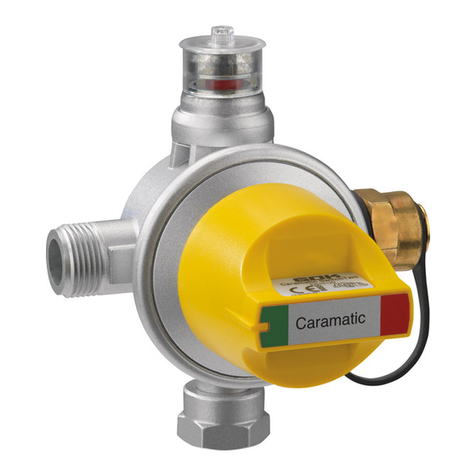
GOK
GOK AUV PS 16 bar User instructions
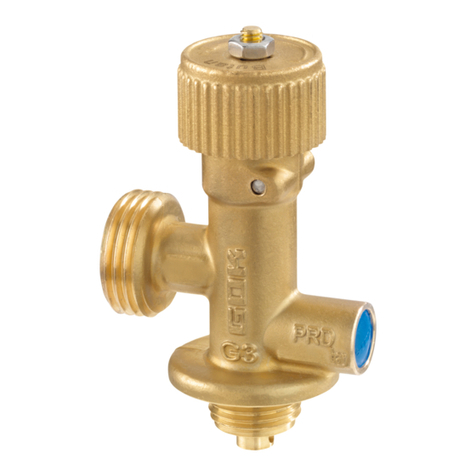
GOK
GOK CGV User manual
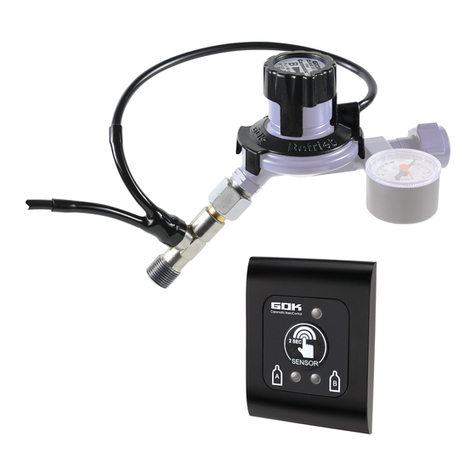
GOK
GOK Caramatic BasicControl User manual
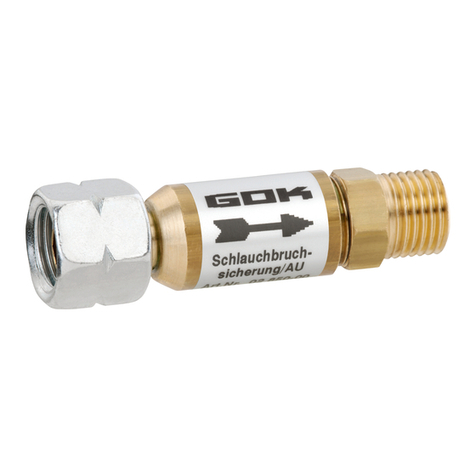
GOK
GOK SBS User instructions

GOK
GOK 0271 User instructions

GOK
GOK AUV-ND User manual
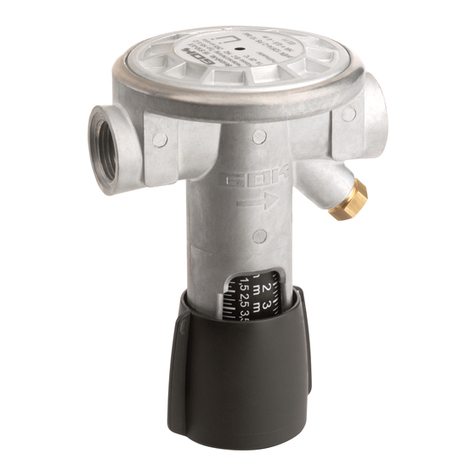
GOK
GOK HS-V.2 User instructions
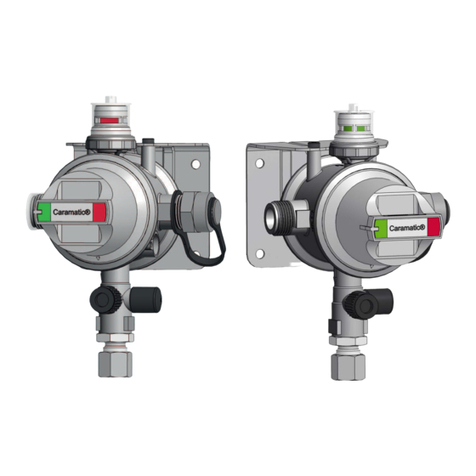
GOK
GOK Caramatic ProTwo User instructions
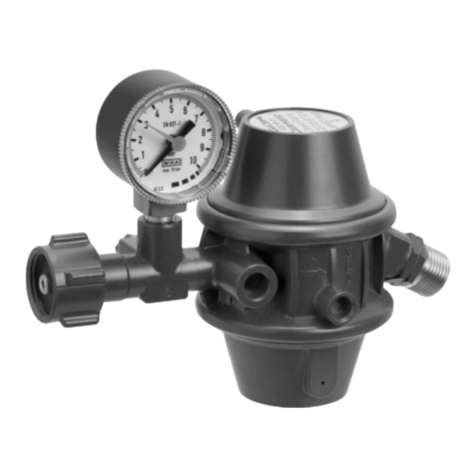
GOK
GOK Caramatic BasicTwo User instructions

